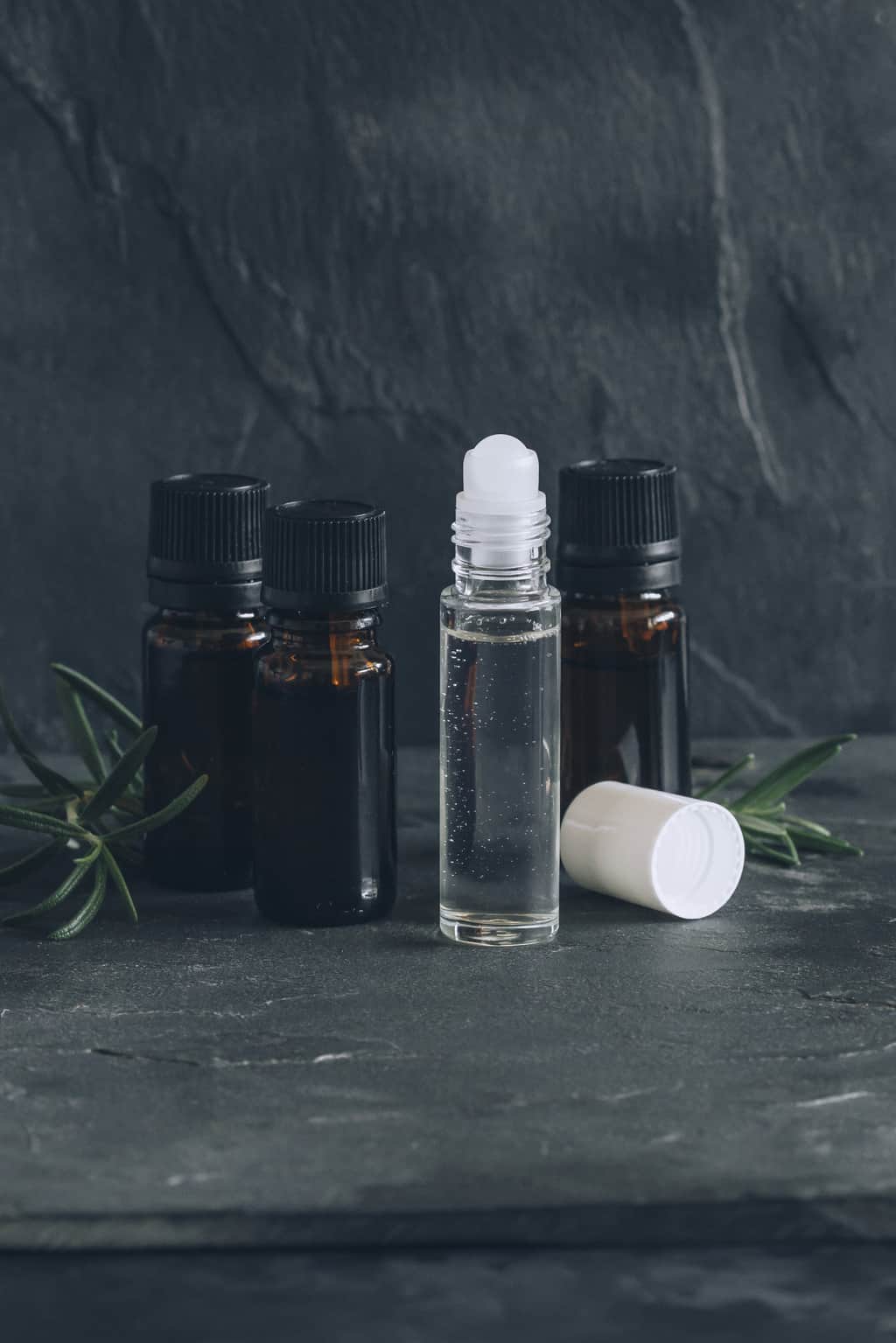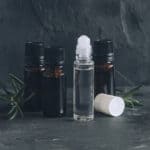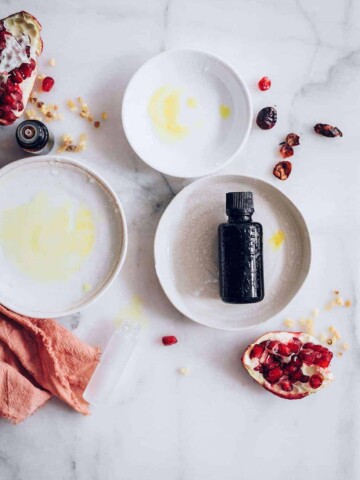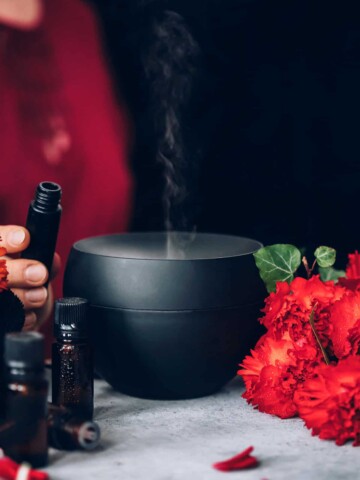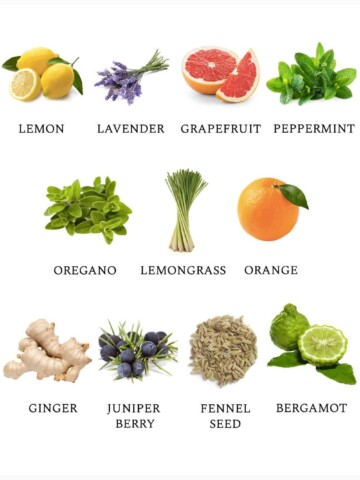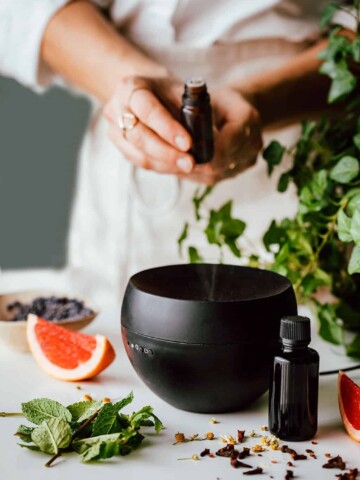I love my ever-growing stash of essential oils. Makeup used to be my impulse purchase; now it’s a new essential oil. So one of my goals is to figure out how to use the darn things, whether it’s in green cleaning or staying healthy.
The great thing about essential oils is that they have such a wide range of health uses. This includes everyday problems from headaches, to sore muscles, to insomnia. And having these essential oils in the form of an aromatherapy roll-on is one of the easiest ways to get the full health benefits.
How to Make Aromatherapy Roll-Ons
Few essential oils can be applied neat, meaning straight onto the skin. Most need to be diluted in a carrier oil, and making an aromatherapy roll-on is hands down the easiest and most effective way to apply essential oils for my family (did I mention I have 3 squirmy kids?).
The hardest part of this process is getting your ingredients together. I love this roller bottle kit, which contains most of the tools you need (aside from the oils). But you can buy everything separately if that’s easier.
Here’s what you’ll need:
- 10 mL glass roll-on bottle applicator (a dark colored bottle will help keep oils from breaking down, but it’s not required)
- About ⅓ of an ounce of carrier oil (10 mL), such as fractionated coconut oil—but olive oil, jojoba, or sweet almond oils will all work
- 8–12 drops of essential oils
- A dropper or pipette makes measuring much easier
Remove the roller ball from the top of the bottle. Add the appropriate number of drops of each essential oil. Fill the rest of the bottle with carrier oil. Reattach the roller ball at the top. Shake well. Store in a cool, dark place.
Always do a test patch on the first use of a new essential oil. When you are ready to use, roll the bottle between your hands to ensure the essential oils are properly mixed with the carrier oil.
Then apply to pressure points on the body, such as the temples, behind the ears, bottoms of the feet, insides of the wrist. Or really anywhere on the skin that feels good to you (avoid eye area and mucus membranes).
Essential Oil Blends for Aromatherapy Roll-Ons
Here are a few of our favorite blends. Feel free to make up your own blends, depending on your particular needs. Just stick to the same overall number of drops, so the dilution will be safe for skin application.
Aromatherapy Roll-on FAQs
What does a carrier oil do?
A carrier oil is a gentle, unscented oil that’s used to dilute essential oils, making them safe for direct skin application. They also "carry" the essential oil into your skin without affecting the oil’s therapeutic benefits.
Where should I apply the oils?
There are a few basic places to apply essential oils:
Wrists and behind the ears – for general aromatherapy
Bottom of the feet – oils are said to be more easily absorbed through the feet. Plus, a good foot massage can be very relaxing!
Temples – perfect for headaches and tension
Abdomen – great for period pain or upset stomachs
That being said, you can technically apply essential oils anywhere on the body: behind the knees, the crown of the head, and the neck. Just be careful not to get into the eyes and mucus membranes.
How often should I re-apply essential oil blends?
Essential oils are powerful, so you should start off applying just once or twice a day. After a few weeks, if you don’t notice any redness or irritation, you can try applying your blend 3–4 times a day.
These oil blends were meant for short-term application. If you feel you need to use an essential oil blend for a long period of time, consult an essential oil practitioner for more specific advice on application and safety of the oils you will be using.
Can you use too much essential oil in your blend?
You don’t want to change the ratio of essential oils to carrier oils because that would alter the dilution and possibly cause skin irritation. Carrier oils help to dilute the essential oils, which prevents skin reactions in most cases. But everyone’s different, and dilution requirements can vary by age, personal sensitivity, and the particular oil you’re using.
Always apply oils cautiously and test them in the recommended diluted form on the inside of your wrist first to see if any irritation crops up. If so, increase the proportion of carrier oil or skip that particular essential oil altogether.
Can I cut the recipe in half and use smaller roller bottles?
Of course! Our ratios are made for 10 mL roller bottles, but cut ’em in half for 5 mL bottles, or double them for 20 mL bottles. Just make sure to adjust the number of essential oil drops accordingly to keep the same ratio to carrier oils for a safe dilution.
Can I store my blends in non-glass bottles?
I don’t recommend it. Essential oils are strong enough to break down plastic, even in small amounts, which can affect the quality of your blends. To be safe, store your aromatherapy roll-on blends in glass bottles made especially for essential oils.
What’s the best affordable essential oil brand?
I use several different essential oil brands, but most of my oils are from Plant Therapy, Aura Cacia, or NOW Foods. Look for organic oils that are humanely harvested and sold directly to consumers to help keep prices down.
How to Make Aromatherapy Roll-Ons
Equipment
- 10 ml glass roller bottle
- Dropper or pipette
Materials
- ⅓ ounce carrier oil (10 mL) such as fractionated coconut oil, olive oil, jojoba or sweet almond
- 8–12 drops essential oils
Instructions
- Remove the roller ball from the top of the bottle.
- Add the appropriate number of drops of each essential oil and fill the rest of the bottle with carrier oil. Reattach roller ball at the top.
- To use: Apply a small test patch of the mixture on first use to make sure you have no reaction before using on multiple skin areas.
- Roll the bottle between your hands before each use to ensure the essential oils are properly mixed with the carrier oil. Then apply to pressure points on the body, such as the temples, behind the ears, bottoms of the feet, insides of the wrist.
Notes
- 7 drops Roman Chamomile
- 5 drops Lavender
- 2 drops Ginger
- 1 drop Black Pepper
- 4 drops Peppermint
- 5 drops Eucalyptus
- 6 drops Clary Sage
- 4 drops Lavender
- 2 drops Lemon
- 4 drops Peppermint
- 2 drops Frankincense
- 4 drops Lemon
- 6 drops Rosemary
- 4 drops Lemon
- 2 drops Peppermint
- 8 drops Orange
- 2 drops Ylang Ylang
- 8 drops Sandalwood
- 2 drops Jasmine
- 8 drops Eucalyptus
- 4 drops Peppermint
- 5 drops Peppermint
- 4 drops Cypress
- 3 drops Lavender
This post was medically reviewed by Dr. Holly Smith, a board-certified physician in nephrology and internal medicine with a background in nutrition. Learn more about Hello Glow's medical review board here. As always, this is not personal medical advice, and we recommend that you talk with your doctor.
685
